Systems and Operations Management: Lamborghini Supply Chain Analysis
VerifiedAdded on 2020/06/05
|19
|6263
|474
Report
AI Summary
This report provides a comprehensive analysis of Lamborghini's systems and operations management, focusing on material management and supply chain strategies. It begins by defining operations management and supply chain management within the context of Lamborghini's luxury car manufacturing. The report explores various approaches to material management, including Material Requirements Planning (MRP), barcodes, stocktaking, material handling, Master Production Scheduling (MPS), and Just-in-Time (JIT) delivery, highlighting their advantages and limitations. Furthermore, it examines the structure of Lamborghini's supply chain, from basic structures to collaborative partnerships and integrated systems. The role of emerging technologies in Lamborghini's supply chain is also discussed, illustrating how the company leverages these advancements to enhance efficiency and maintain a competitive edge. The report underscores the importance of these strategies in achieving operational excellence within the automotive industry, particularly in the context of luxury car manufacturing.
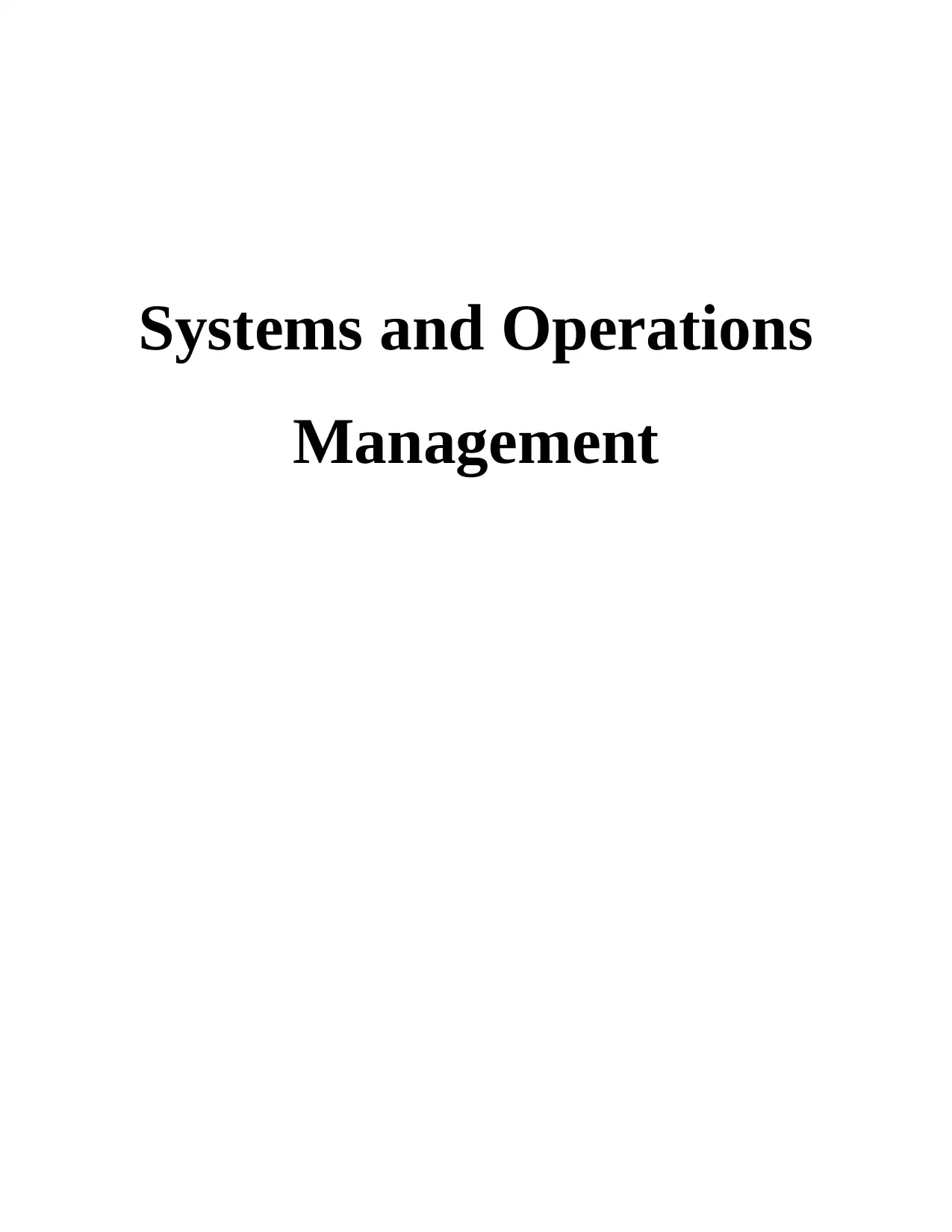
Systems and Operations
Management
Management
Paraphrase This Document
Need a fresh take? Get an instant paraphrase of this document with our AI Paraphraser
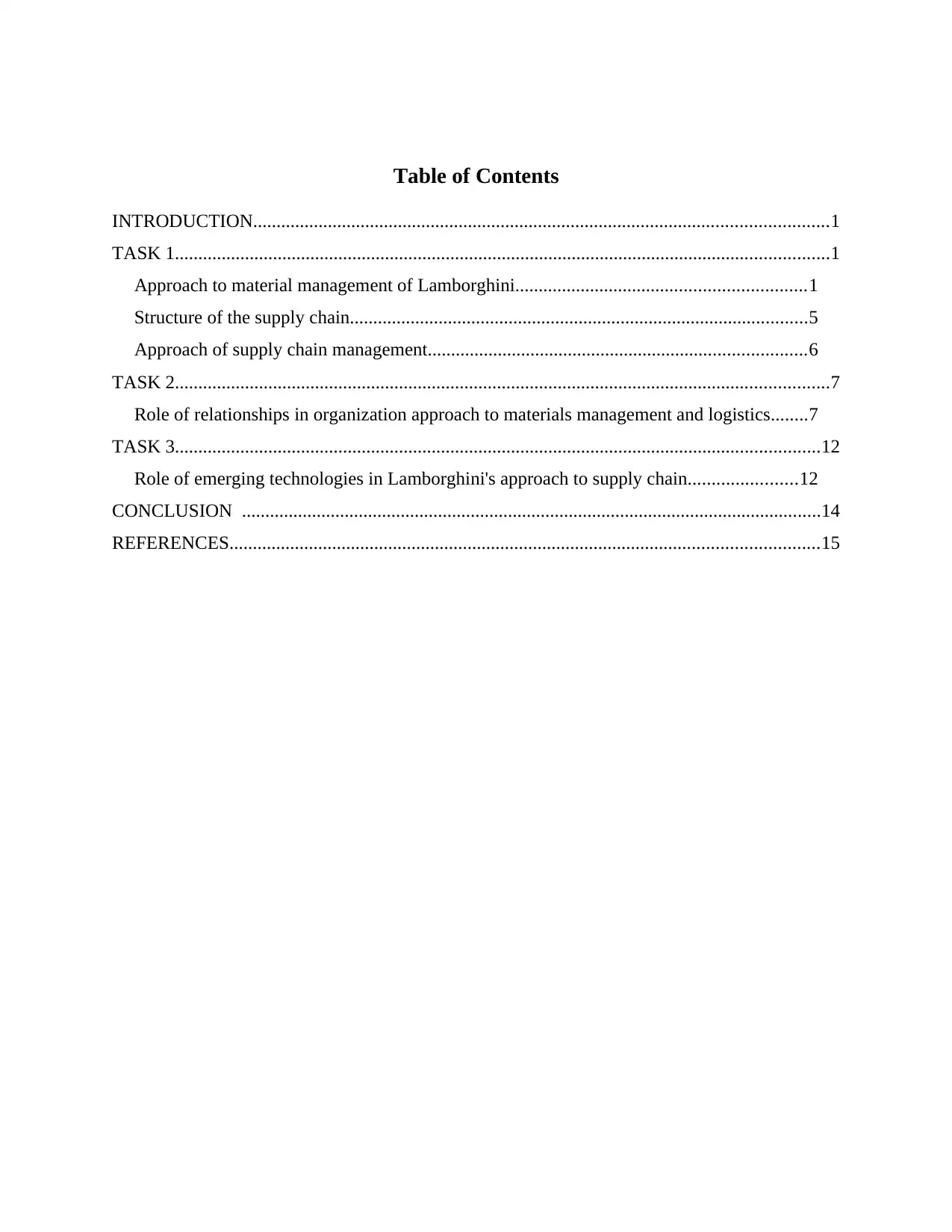
Table of Contents
INTRODUCTION...........................................................................................................................1
TASK 1............................................................................................................................................1
Approach to material management of Lamborghini..............................................................1
Structure of the supply chain..................................................................................................5
Approach of supply chain management.................................................................................6
TASK 2............................................................................................................................................7
Role of relationships in organization approach to materials management and logistics........7
TASK 3..........................................................................................................................................12
Role of emerging technologies in Lamborghini's approach to supply chain.......................12
CONCLUSION ............................................................................................................................14
REFERENCES..............................................................................................................................15
INTRODUCTION...........................................................................................................................1
TASK 1............................................................................................................................................1
Approach to material management of Lamborghini..............................................................1
Structure of the supply chain..................................................................................................5
Approach of supply chain management.................................................................................6
TASK 2............................................................................................................................................7
Role of relationships in organization approach to materials management and logistics........7
TASK 3..........................................................................................................................................12
Role of emerging technologies in Lamborghini's approach to supply chain.......................12
CONCLUSION ............................................................................................................................14
REFERENCES..............................................................................................................................15
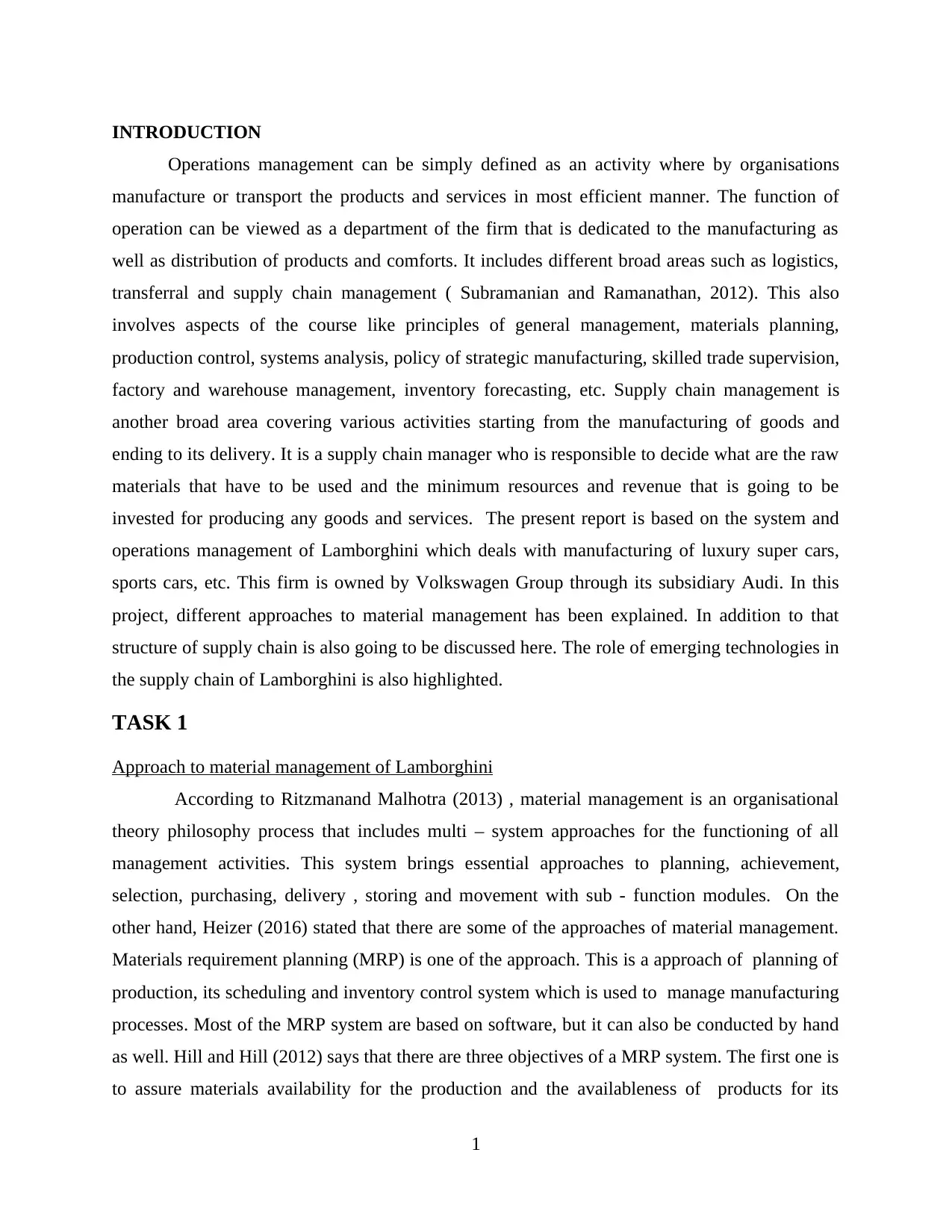
INTRODUCTION
Operations management can be simply defined as an activity where by organisations
manufacture or transport the products and services in most efficient manner. The function of
operation can be viewed as a department of the firm that is dedicated to the manufacturing as
well as distribution of products and comforts. It includes different broad areas such as logistics,
transferral and supply chain management ( Subramanian and Ramanathan, 2012). This also
involves aspects of the course like principles of general management, materials planning,
production control, systems analysis, policy of strategic manufacturing, skilled trade supervision,
factory and warehouse management, inventory forecasting, etc. Supply chain management is
another broad area covering various activities starting from the manufacturing of goods and
ending to its delivery. It is a supply chain manager who is responsible to decide what are the raw
materials that have to be used and the minimum resources and revenue that is going to be
invested for producing any goods and services. The present report is based on the system and
operations management of Lamborghini which deals with manufacturing of luxury super cars,
sports cars, etc. This firm is owned by Volkswagen Group through its subsidiary Audi. In this
project, different approaches to material management has been explained. In addition to that
structure of supply chain is also going to be discussed here. The role of emerging technologies in
the supply chain of Lamborghini is also highlighted.
TASK 1
Approach to material management of Lamborghini
According to Ritzmanand Malhotra (2013) , material management is an organisational
theory philosophy process that includes multi – system approaches for the functioning of all
management activities. This system brings essential approaches to planning, achievement,
selection, purchasing, delivery , storing and movement with sub - function modules. On the
other hand, Heizer (2016) stated that there are some of the approaches of material management.
Materials requirement planning (MRP) is one of the approach. This is a approach of planning of
production, its scheduling and inventory control system which is used to manage manufacturing
processes. Most of the MRP system are based on software, but it can also be conducted by hand
as well. Hill and Hill (2012) says that there are three objectives of a MRP system. The first one is
to assure materials availability for the production and the availableness of products for its
1
Operations management can be simply defined as an activity where by organisations
manufacture or transport the products and services in most efficient manner. The function of
operation can be viewed as a department of the firm that is dedicated to the manufacturing as
well as distribution of products and comforts. It includes different broad areas such as logistics,
transferral and supply chain management ( Subramanian and Ramanathan, 2012). This also
involves aspects of the course like principles of general management, materials planning,
production control, systems analysis, policy of strategic manufacturing, skilled trade supervision,
factory and warehouse management, inventory forecasting, etc. Supply chain management is
another broad area covering various activities starting from the manufacturing of goods and
ending to its delivery. It is a supply chain manager who is responsible to decide what are the raw
materials that have to be used and the minimum resources and revenue that is going to be
invested for producing any goods and services. The present report is based on the system and
operations management of Lamborghini which deals with manufacturing of luxury super cars,
sports cars, etc. This firm is owned by Volkswagen Group through its subsidiary Audi. In this
project, different approaches to material management has been explained. In addition to that
structure of supply chain is also going to be discussed here. The role of emerging technologies in
the supply chain of Lamborghini is also highlighted.
TASK 1
Approach to material management of Lamborghini
According to Ritzmanand Malhotra (2013) , material management is an organisational
theory philosophy process that includes multi – system approaches for the functioning of all
management activities. This system brings essential approaches to planning, achievement,
selection, purchasing, delivery , storing and movement with sub - function modules. On the
other hand, Heizer (2016) stated that there are some of the approaches of material management.
Materials requirement planning (MRP) is one of the approach. This is a approach of planning of
production, its scheduling and inventory control system which is used to manage manufacturing
processes. Most of the MRP system are based on software, but it can also be conducted by hand
as well. Hill and Hill (2012) says that there are three objectives of a MRP system. The first one is
to assure materials availability for the production and the availableness of products for its
1
⊘ This is a preview!⊘
Do you want full access?
Subscribe today to unlock all pages.

Trusted by 1+ million students worldwide
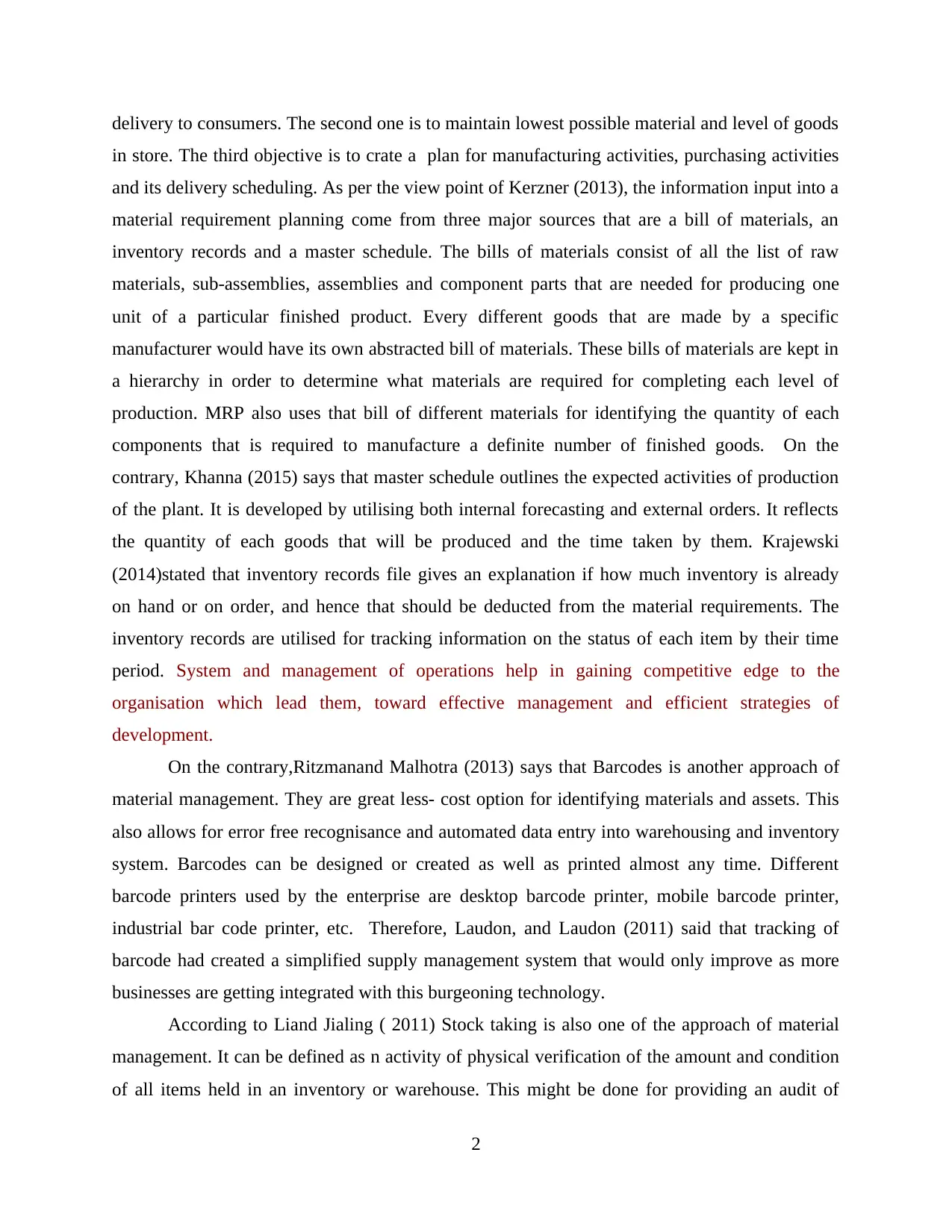
delivery to consumers. The second one is to maintain lowest possible material and level of goods
in store. The third objective is to crate a plan for manufacturing activities, purchasing activities
and its delivery scheduling. As per the view point of Kerzner (2013), the information input into a
material requirement planning come from three major sources that are a bill of materials, an
inventory records and a master schedule. The bills of materials consist of all the list of raw
materials, sub-assemblies, assemblies and component parts that are needed for producing one
unit of a particular finished product. Every different goods that are made by a specific
manufacturer would have its own abstracted bill of materials. These bills of materials are kept in
a hierarchy in order to determine what materials are required for completing each level of
production. MRP also uses that bill of different materials for identifying the quantity of each
components that is required to manufacture a definite number of finished goods. On the
contrary, Khanna (2015) says that master schedule outlines the expected activities of production
of the plant. It is developed by utilising both internal forecasting and external orders. It reflects
the quantity of each goods that will be produced and the time taken by them. Krajewski
(2014)stated that inventory records file gives an explanation if how much inventory is already
on hand or on order, and hence that should be deducted from the material requirements. The
inventory records are utilised for tracking information on the status of each item by their time
period. System and management of operations help in gaining competitive edge to the
organisation which lead them, toward effective management and efficient strategies of
development.
On the contrary,Ritzmanand Malhotra (2013) says that Barcodes is another approach of
material management. They are great less- cost option for identifying materials and assets. This
also allows for error free recognisance and automated data entry into warehousing and inventory
system. Barcodes can be designed or created as well as printed almost any time. Different
barcode printers used by the enterprise are desktop barcode printer, mobile barcode printer,
industrial bar code printer, etc. Therefore, Laudon, and Laudon (2011) said that tracking of
barcode had created a simplified supply management system that would only improve as more
businesses are getting integrated with this burgeoning technology.
According to Liand Jialing ( 2011) Stock taking is also one of the approach of material
management. It can be defined as n activity of physical verification of the amount and condition
of all items held in an inventory or warehouse. This might be done for providing an audit of
2
in store. The third objective is to crate a plan for manufacturing activities, purchasing activities
and its delivery scheduling. As per the view point of Kerzner (2013), the information input into a
material requirement planning come from three major sources that are a bill of materials, an
inventory records and a master schedule. The bills of materials consist of all the list of raw
materials, sub-assemblies, assemblies and component parts that are needed for producing one
unit of a particular finished product. Every different goods that are made by a specific
manufacturer would have its own abstracted bill of materials. These bills of materials are kept in
a hierarchy in order to determine what materials are required for completing each level of
production. MRP also uses that bill of different materials for identifying the quantity of each
components that is required to manufacture a definite number of finished goods. On the
contrary, Khanna (2015) says that master schedule outlines the expected activities of production
of the plant. It is developed by utilising both internal forecasting and external orders. It reflects
the quantity of each goods that will be produced and the time taken by them. Krajewski
(2014)stated that inventory records file gives an explanation if how much inventory is already
on hand or on order, and hence that should be deducted from the material requirements. The
inventory records are utilised for tracking information on the status of each item by their time
period. System and management of operations help in gaining competitive edge to the
organisation which lead them, toward effective management and efficient strategies of
development.
On the contrary,Ritzmanand Malhotra (2013) says that Barcodes is another approach of
material management. They are great less- cost option for identifying materials and assets. This
also allows for error free recognisance and automated data entry into warehousing and inventory
system. Barcodes can be designed or created as well as printed almost any time. Different
barcode printers used by the enterprise are desktop barcode printer, mobile barcode printer,
industrial bar code printer, etc. Therefore, Laudon, and Laudon (2011) said that tracking of
barcode had created a simplified supply management system that would only improve as more
businesses are getting integrated with this burgeoning technology.
According to Liand Jialing ( 2011) Stock taking is also one of the approach of material
management. It can be defined as n activity of physical verification of the amount and condition
of all items held in an inventory or warehouse. This might be done for providing an audit of
2
Paraphrase This Document
Need a fresh take? Get an instant paraphrase of this document with our AI Paraphraser
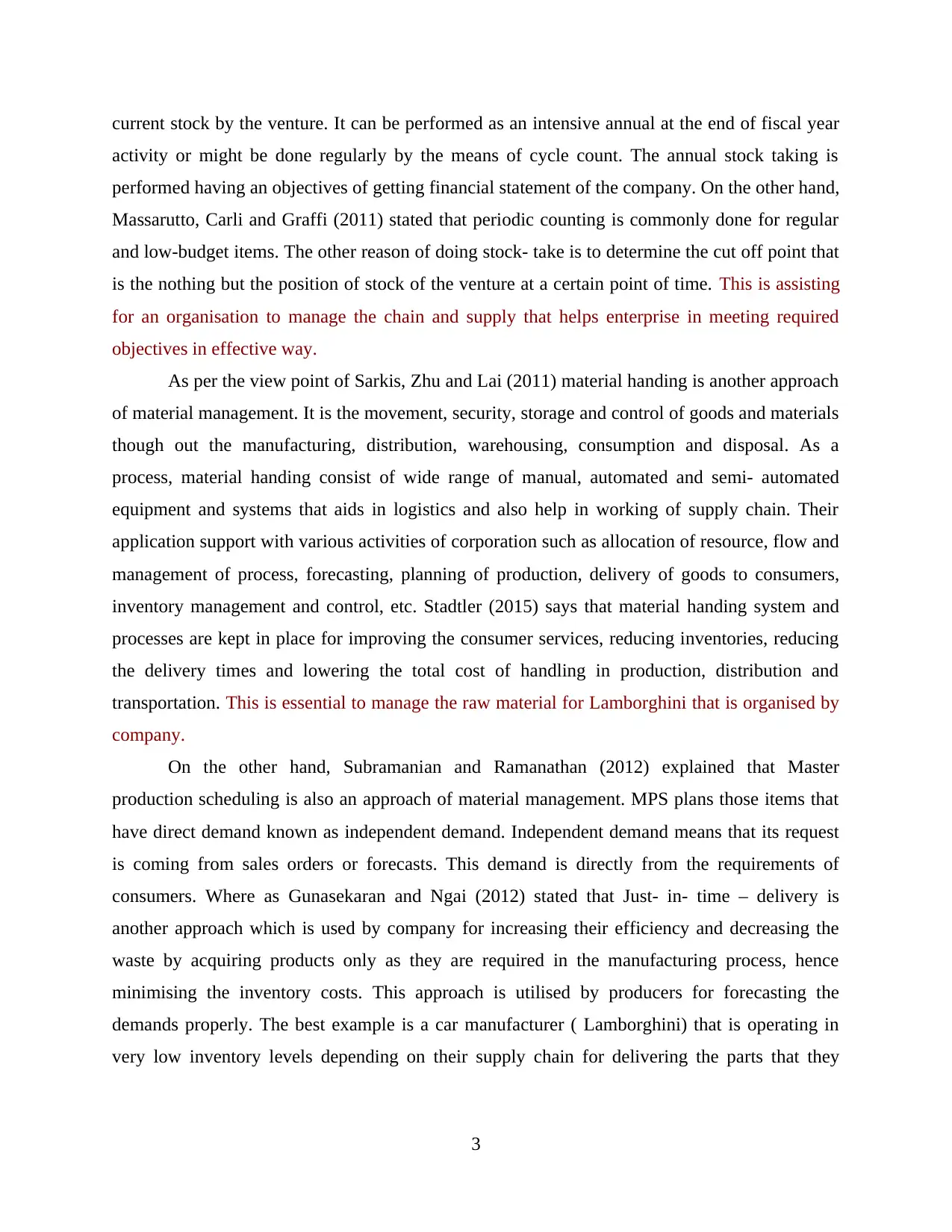
current stock by the venture. It can be performed as an intensive annual at the end of fiscal year
activity or might be done regularly by the means of cycle count. The annual stock taking is
performed having an objectives of getting financial statement of the company. On the other hand,
Massarutto, Carli and Graffi (2011) stated that periodic counting is commonly done for regular
and low-budget items. The other reason of doing stock- take is to determine the cut off point that
is the nothing but the position of stock of the venture at a certain point of time. This is assisting
for an organisation to manage the chain and supply that helps enterprise in meeting required
objectives in effective way.
As per the view point of Sarkis, Zhu and Lai (2011) material handing is another approach
of material management. It is the movement, security, storage and control of goods and materials
though out the manufacturing, distribution, warehousing, consumption and disposal. As a
process, material handing consist of wide range of manual, automated and semi- automated
equipment and systems that aids in logistics and also help in working of supply chain. Their
application support with various activities of corporation such as allocation of resource, flow and
management of process, forecasting, planning of production, delivery of goods to consumers,
inventory management and control, etc. Stadtler (2015) says that material handing system and
processes are kept in place for improving the consumer services, reducing inventories, reducing
the delivery times and lowering the total cost of handling in production, distribution and
transportation. This is essential to manage the raw material for Lamborghini that is organised by
company.
On the other hand, Subramanian and Ramanathan (2012) explained that Master
production scheduling is also an approach of material management. MPS plans those items that
have direct demand known as independent demand. Independent demand means that its request
is coming from sales orders or forecasts. This demand is directly from the requirements of
consumers. Where as Gunasekaran and Ngai (2012) stated that Just- in- time – delivery is
another approach which is used by company for increasing their efficiency and decreasing the
waste by acquiring products only as they are required in the manufacturing process, hence
minimising the inventory costs. This approach is utilised by producers for forecasting the
demands properly. The best example is a car manufacturer ( Lamborghini) that is operating in
very low inventory levels depending on their supply chain for delivering the parts that they
3
activity or might be done regularly by the means of cycle count. The annual stock taking is
performed having an objectives of getting financial statement of the company. On the other hand,
Massarutto, Carli and Graffi (2011) stated that periodic counting is commonly done for regular
and low-budget items. The other reason of doing stock- take is to determine the cut off point that
is the nothing but the position of stock of the venture at a certain point of time. This is assisting
for an organisation to manage the chain and supply that helps enterprise in meeting required
objectives in effective way.
As per the view point of Sarkis, Zhu and Lai (2011) material handing is another approach
of material management. It is the movement, security, storage and control of goods and materials
though out the manufacturing, distribution, warehousing, consumption and disposal. As a
process, material handing consist of wide range of manual, automated and semi- automated
equipment and systems that aids in logistics and also help in working of supply chain. Their
application support with various activities of corporation such as allocation of resource, flow and
management of process, forecasting, planning of production, delivery of goods to consumers,
inventory management and control, etc. Stadtler (2015) says that material handing system and
processes are kept in place for improving the consumer services, reducing inventories, reducing
the delivery times and lowering the total cost of handling in production, distribution and
transportation. This is essential to manage the raw material for Lamborghini that is organised by
company.
On the other hand, Subramanian and Ramanathan (2012) explained that Master
production scheduling is also an approach of material management. MPS plans those items that
have direct demand known as independent demand. Independent demand means that its request
is coming from sales orders or forecasts. This demand is directly from the requirements of
consumers. Where as Gunasekaran and Ngai (2012) stated that Just- in- time – delivery is
another approach which is used by company for increasing their efficiency and decreasing the
waste by acquiring products only as they are required in the manufacturing process, hence
minimising the inventory costs. This approach is utilised by producers for forecasting the
demands properly. The best example is a car manufacturer ( Lamborghini) that is operating in
very low inventory levels depending on their supply chain for delivering the parts that they
3
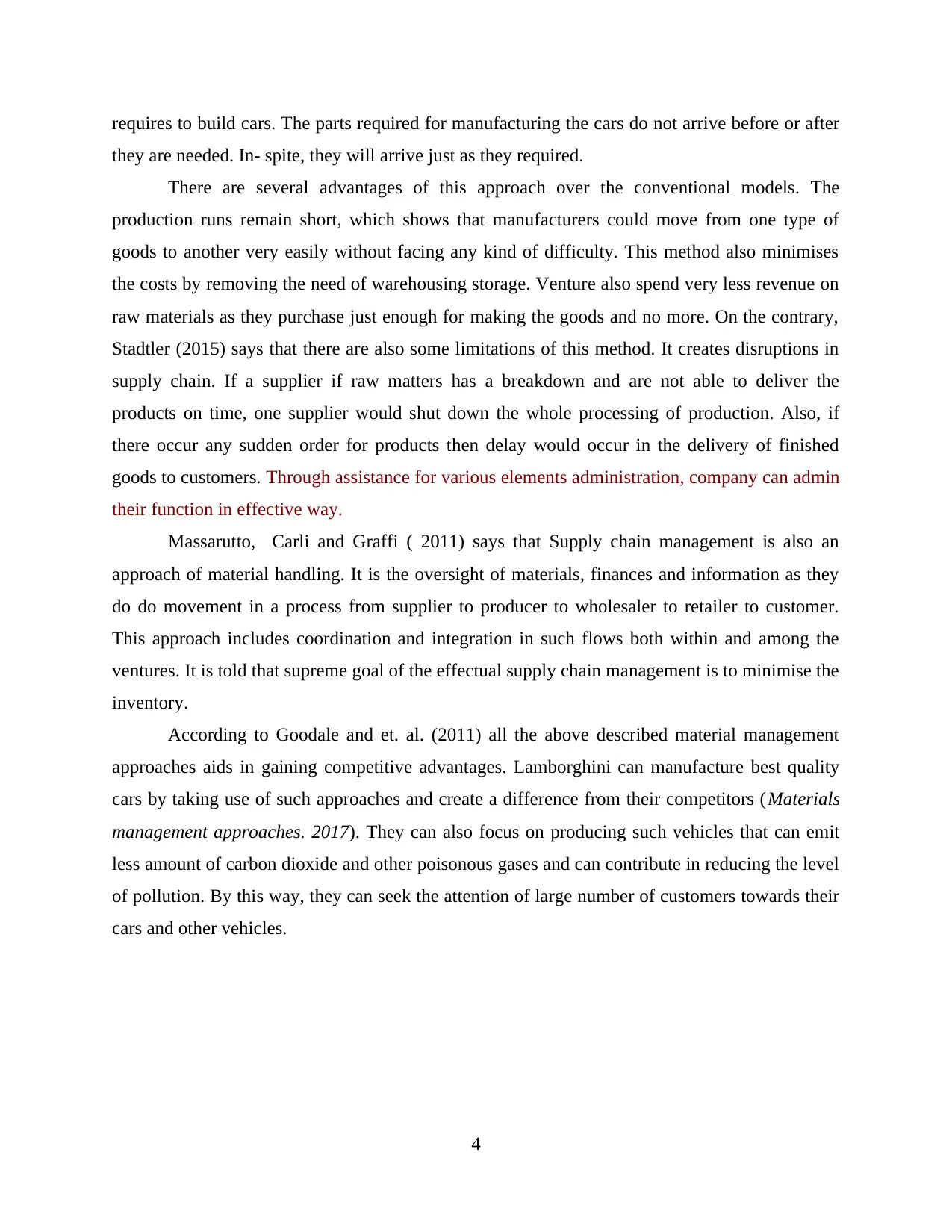
requires to build cars. The parts required for manufacturing the cars do not arrive before or after
they are needed. In- spite, they will arrive just as they required.
There are several advantages of this approach over the conventional models. The
production runs remain short, which shows that manufacturers could move from one type of
goods to another very easily without facing any kind of difficulty. This method also minimises
the costs by removing the need of warehousing storage. Venture also spend very less revenue on
raw materials as they purchase just enough for making the goods and no more. On the contrary,
Stadtler (2015) says that there are also some limitations of this method. It creates disruptions in
supply chain. If a supplier if raw matters has a breakdown and are not able to deliver the
products on time, one supplier would shut down the whole processing of production. Also, if
there occur any sudden order for products then delay would occur in the delivery of finished
goods to customers. Through assistance for various elements administration, company can admin
their function in effective way.
Massarutto, Carli and Graffi ( 2011) says that Supply chain management is also an
approach of material handling. It is the oversight of materials, finances and information as they
do do movement in a process from supplier to producer to wholesaler to retailer to customer.
This approach includes coordination and integration in such flows both within and among the
ventures. It is told that supreme goal of the effectual supply chain management is to minimise the
inventory.
According to Goodale and et. al. (2011) all the above described material management
approaches aids in gaining competitive advantages. Lamborghini can manufacture best quality
cars by taking use of such approaches and create a difference from their competitors (Materials
management approaches. 2017). They can also focus on producing such vehicles that can emit
less amount of carbon dioxide and other poisonous gases and can contribute in reducing the level
of pollution. By this way, they can seek the attention of large number of customers towards their
cars and other vehicles.
4
they are needed. In- spite, they will arrive just as they required.
There are several advantages of this approach over the conventional models. The
production runs remain short, which shows that manufacturers could move from one type of
goods to another very easily without facing any kind of difficulty. This method also minimises
the costs by removing the need of warehousing storage. Venture also spend very less revenue on
raw materials as they purchase just enough for making the goods and no more. On the contrary,
Stadtler (2015) says that there are also some limitations of this method. It creates disruptions in
supply chain. If a supplier if raw matters has a breakdown and are not able to deliver the
products on time, one supplier would shut down the whole processing of production. Also, if
there occur any sudden order for products then delay would occur in the delivery of finished
goods to customers. Through assistance for various elements administration, company can admin
their function in effective way.
Massarutto, Carli and Graffi ( 2011) says that Supply chain management is also an
approach of material handling. It is the oversight of materials, finances and information as they
do do movement in a process from supplier to producer to wholesaler to retailer to customer.
This approach includes coordination and integration in such flows both within and among the
ventures. It is told that supreme goal of the effectual supply chain management is to minimise the
inventory.
According to Goodale and et. al. (2011) all the above described material management
approaches aids in gaining competitive advantages. Lamborghini can manufacture best quality
cars by taking use of such approaches and create a difference from their competitors (Materials
management approaches. 2017). They can also focus on producing such vehicles that can emit
less amount of carbon dioxide and other poisonous gases and can contribute in reducing the level
of pollution. By this way, they can seek the attention of large number of customers towards their
cars and other vehicles.
4
⊘ This is a preview!⊘
Do you want full access?
Subscribe today to unlock all pages.

Trusted by 1+ million students worldwide
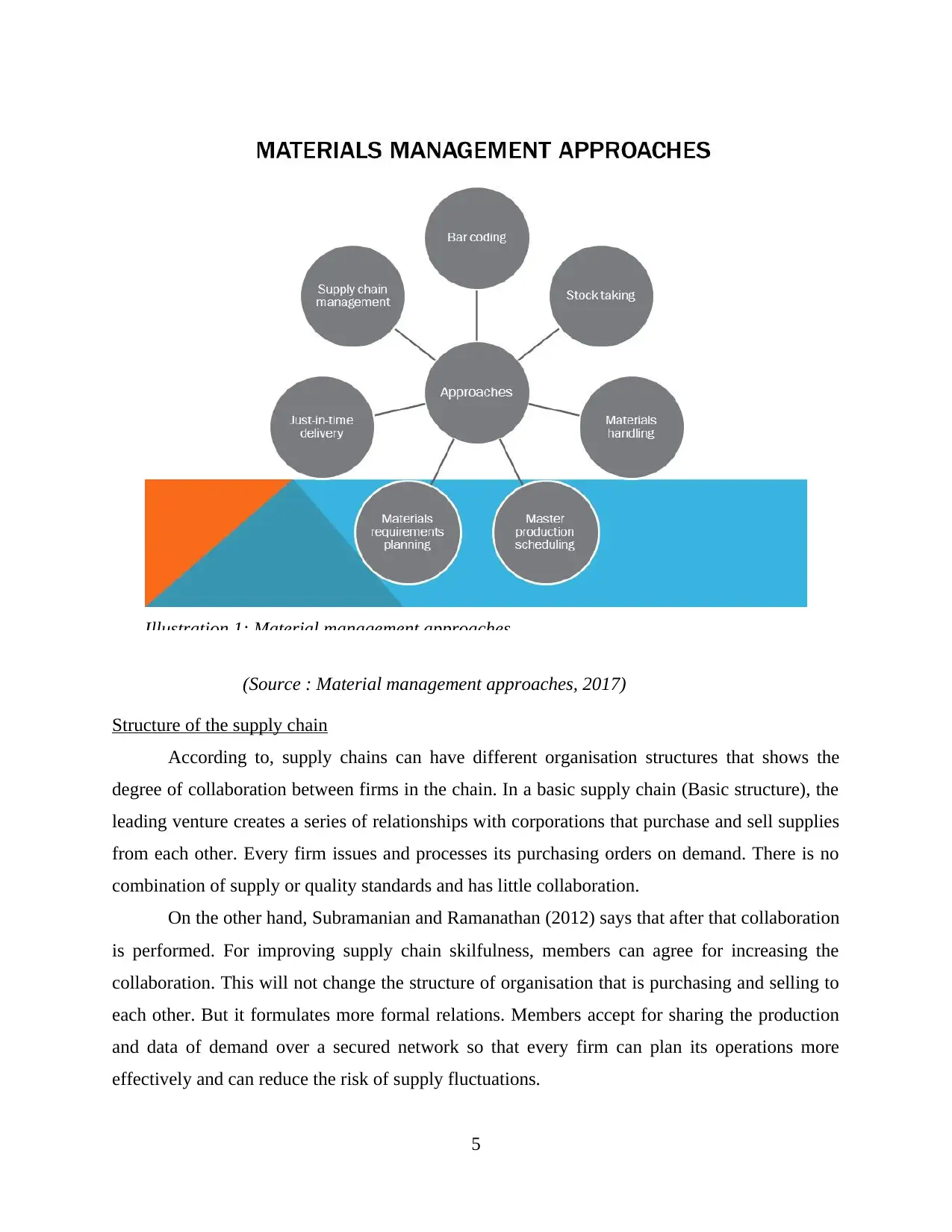
(Source : Material management approaches, 2017)
Structure of the supply chain
According to, supply chains can have different organisation structures that shows the
degree of collaboration between firms in the chain. In a basic supply chain (Basic structure), the
leading venture creates a series of relationships with corporations that purchase and sell supplies
from each other. Every firm issues and processes its purchasing orders on demand. There is no
combination of supply or quality standards and has little collaboration.
On the other hand, Subramanian and Ramanathan (2012) says that after that collaboration
is performed. For improving supply chain skilfulness, members can agree for increasing the
collaboration. This will not change the structure of organisation that is purchasing and selling to
each other. But it formulates more formal relations. Members accept for sharing the production
and data of demand over a secured network so that every firm can plan its operations more
effectively and can reduce the risk of supply fluctuations.
5
Illustration 1: Material management approaches
Structure of the supply chain
According to, supply chains can have different organisation structures that shows the
degree of collaboration between firms in the chain. In a basic supply chain (Basic structure), the
leading venture creates a series of relationships with corporations that purchase and sell supplies
from each other. Every firm issues and processes its purchasing orders on demand. There is no
combination of supply or quality standards and has little collaboration.
On the other hand, Subramanian and Ramanathan (2012) says that after that collaboration
is performed. For improving supply chain skilfulness, members can agree for increasing the
collaboration. This will not change the structure of organisation that is purchasing and selling to
each other. But it formulates more formal relations. Members accept for sharing the production
and data of demand over a secured network so that every firm can plan its operations more
effectively and can reduce the risk of supply fluctuations.
5
Illustration 1: Material management approaches
Paraphrase This Document
Need a fresh take? Get an instant paraphrase of this document with our AI Paraphraser
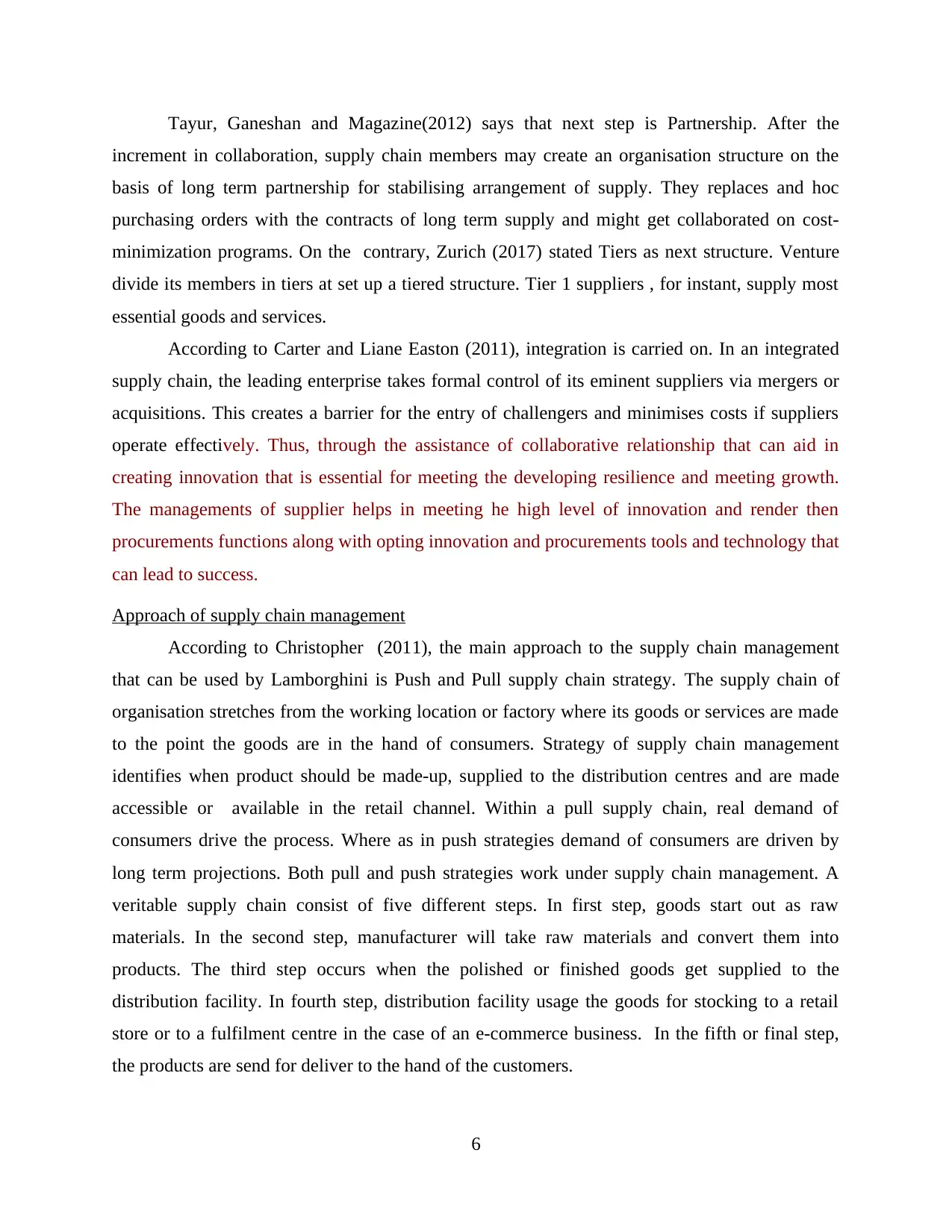
Tayur, Ganeshan and Magazine(2012) says that next step is Partnership. After the
increment in collaboration, supply chain members may create an organisation structure on the
basis of long term partnership for stabilising arrangement of supply. They replaces and hoc
purchasing orders with the contracts of long term supply and might get collaborated on cost-
minimization programs. On the contrary, Zurich (2017) stated Tiers as next structure. Venture
divide its members in tiers at set up a tiered structure. Tier 1 suppliers , for instant, supply most
essential goods and services.
According to Carter and Liane Easton (2011), integration is carried on. In an integrated
supply chain, the leading enterprise takes formal control of its eminent suppliers via mergers or
acquisitions. This creates a barrier for the entry of challengers and minimises costs if suppliers
operate effectively. Thus, through the assistance of collaborative relationship that can aid in
creating innovation that is essential for meeting the developing resilience and meeting growth.
The managements of supplier helps in meeting he high level of innovation and render then
procurements functions along with opting innovation and procurements tools and technology that
can lead to success.
Approach of supply chain management
According to Christopher (2011), the main approach to the supply chain management
that can be used by Lamborghini is Push and Pull supply chain strategy. The supply chain of
organisation stretches from the working location or factory where its goods or services are made
to the point the goods are in the hand of consumers. Strategy of supply chain management
identifies when product should be made-up, supplied to the distribution centres and are made
accessible or available in the retail channel. Within a pull supply chain, real demand of
consumers drive the process. Where as in push strategies demand of consumers are driven by
long term projections. Both pull and push strategies work under supply chain management. A
veritable supply chain consist of five different steps. In first step, goods start out as raw
materials. In the second step, manufacturer will take raw materials and convert them into
products. The third step occurs when the polished or finished goods get supplied to the
distribution facility. In fourth step, distribution facility usage the goods for stocking to a retail
store or to a fulfilment centre in the case of an e-commerce business. In the fifth or final step,
the products are send for deliver to the hand of the customers.
6
increment in collaboration, supply chain members may create an organisation structure on the
basis of long term partnership for stabilising arrangement of supply. They replaces and hoc
purchasing orders with the contracts of long term supply and might get collaborated on cost-
minimization programs. On the contrary, Zurich (2017) stated Tiers as next structure. Venture
divide its members in tiers at set up a tiered structure. Tier 1 suppliers , for instant, supply most
essential goods and services.
According to Carter and Liane Easton (2011), integration is carried on. In an integrated
supply chain, the leading enterprise takes formal control of its eminent suppliers via mergers or
acquisitions. This creates a barrier for the entry of challengers and minimises costs if suppliers
operate effectively. Thus, through the assistance of collaborative relationship that can aid in
creating innovation that is essential for meeting the developing resilience and meeting growth.
The managements of supplier helps in meeting he high level of innovation and render then
procurements functions along with opting innovation and procurements tools and technology that
can lead to success.
Approach of supply chain management
According to Christopher (2011), the main approach to the supply chain management
that can be used by Lamborghini is Push and Pull supply chain strategy. The supply chain of
organisation stretches from the working location or factory where its goods or services are made
to the point the goods are in the hand of consumers. Strategy of supply chain management
identifies when product should be made-up, supplied to the distribution centres and are made
accessible or available in the retail channel. Within a pull supply chain, real demand of
consumers drive the process. Where as in push strategies demand of consumers are driven by
long term projections. Both pull and push strategies work under supply chain management. A
veritable supply chain consist of five different steps. In first step, goods start out as raw
materials. In the second step, manufacturer will take raw materials and convert them into
products. The third step occurs when the polished or finished goods get supplied to the
distribution facility. In fourth step, distribution facility usage the goods for stocking to a retail
store or to a fulfilment centre in the case of an e-commerce business. In the fifth or final step,
the products are send for deliver to the hand of the customers.
6
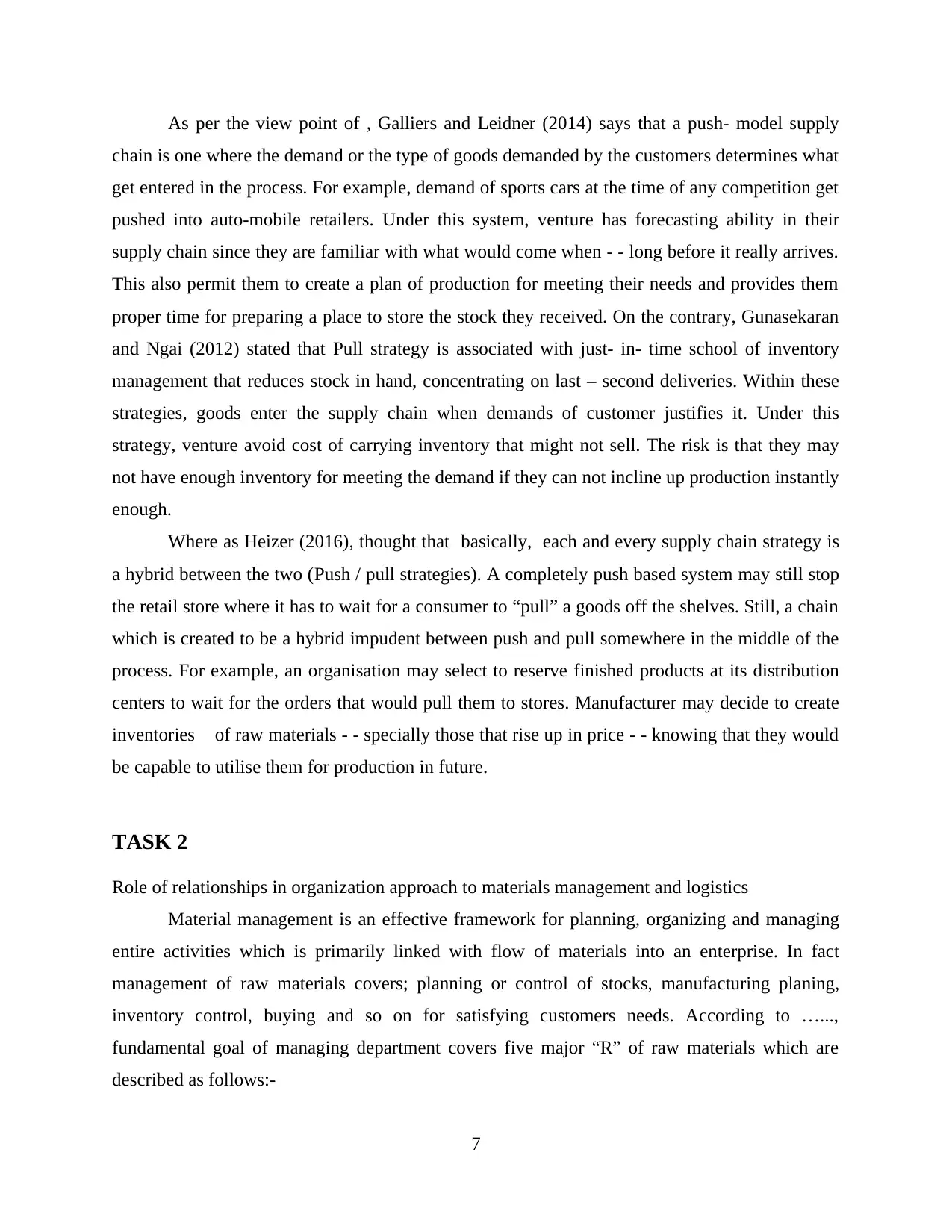
As per the view point of , Galliers and Leidner (2014) says that a push- model supply
chain is one where the demand or the type of goods demanded by the customers determines what
get entered in the process. For example, demand of sports cars at the time of any competition get
pushed into auto-mobile retailers. Under this system, venture has forecasting ability in their
supply chain since they are familiar with what would come when - - long before it really arrives.
This also permit them to create a plan of production for meeting their needs and provides them
proper time for preparing a place to store the stock they received. On the contrary, Gunasekaran
and Ngai (2012) stated that Pull strategy is associated with just- in- time school of inventory
management that reduces stock in hand, concentrating on last – second deliveries. Within these
strategies, goods enter the supply chain when demands of customer justifies it. Under this
strategy, venture avoid cost of carrying inventory that might not sell. The risk is that they may
not have enough inventory for meeting the demand if they can not incline up production instantly
enough.
Where as Heizer (2016), thought that basically, each and every supply chain strategy is
a hybrid between the two (Push / pull strategies). A completely push based system may still stop
the retail store where it has to wait for a consumer to “pull” a goods off the shelves. Still, a chain
which is created to be a hybrid impudent between push and pull somewhere in the middle of the
process. For example, an organisation may select to reserve finished products at its distribution
centers to wait for the orders that would pull them to stores. Manufacturer may decide to create
inventories of raw materials - - specially those that rise up in price - - knowing that they would
be capable to utilise them for production in future.
TASK 2
Role of relationships in organization approach to materials management and logistics
Material management is an effective framework for planning, organizing and managing
entire activities which is primarily linked with flow of materials into an enterprise. In fact
management of raw materials covers; planning or control of stocks, manufacturing planing,
inventory control, buying and so on for satisfying customers needs. According to …...,
fundamental goal of managing department covers five major “R” of raw materials which are
described as follows:-
7
chain is one where the demand or the type of goods demanded by the customers determines what
get entered in the process. For example, demand of sports cars at the time of any competition get
pushed into auto-mobile retailers. Under this system, venture has forecasting ability in their
supply chain since they are familiar with what would come when - - long before it really arrives.
This also permit them to create a plan of production for meeting their needs and provides them
proper time for preparing a place to store the stock they received. On the contrary, Gunasekaran
and Ngai (2012) stated that Pull strategy is associated with just- in- time school of inventory
management that reduces stock in hand, concentrating on last – second deliveries. Within these
strategies, goods enter the supply chain when demands of customer justifies it. Under this
strategy, venture avoid cost of carrying inventory that might not sell. The risk is that they may
not have enough inventory for meeting the demand if they can not incline up production instantly
enough.
Where as Heizer (2016), thought that basically, each and every supply chain strategy is
a hybrid between the two (Push / pull strategies). A completely push based system may still stop
the retail store where it has to wait for a consumer to “pull” a goods off the shelves. Still, a chain
which is created to be a hybrid impudent between push and pull somewhere in the middle of the
process. For example, an organisation may select to reserve finished products at its distribution
centers to wait for the orders that would pull them to stores. Manufacturer may decide to create
inventories of raw materials - - specially those that rise up in price - - knowing that they would
be capable to utilise them for production in future.
TASK 2
Role of relationships in organization approach to materials management and logistics
Material management is an effective framework for planning, organizing and managing
entire activities which is primarily linked with flow of materials into an enterprise. In fact
management of raw materials covers; planning or control of stocks, manufacturing planing,
inventory control, buying and so on for satisfying customers needs. According to …...,
fundamental goal of managing department covers five major “R” of raw materials which are
described as follows:-
7
⊘ This is a preview!⊘
Do you want full access?
Subscribe today to unlock all pages.

Trusted by 1+ million students worldwide
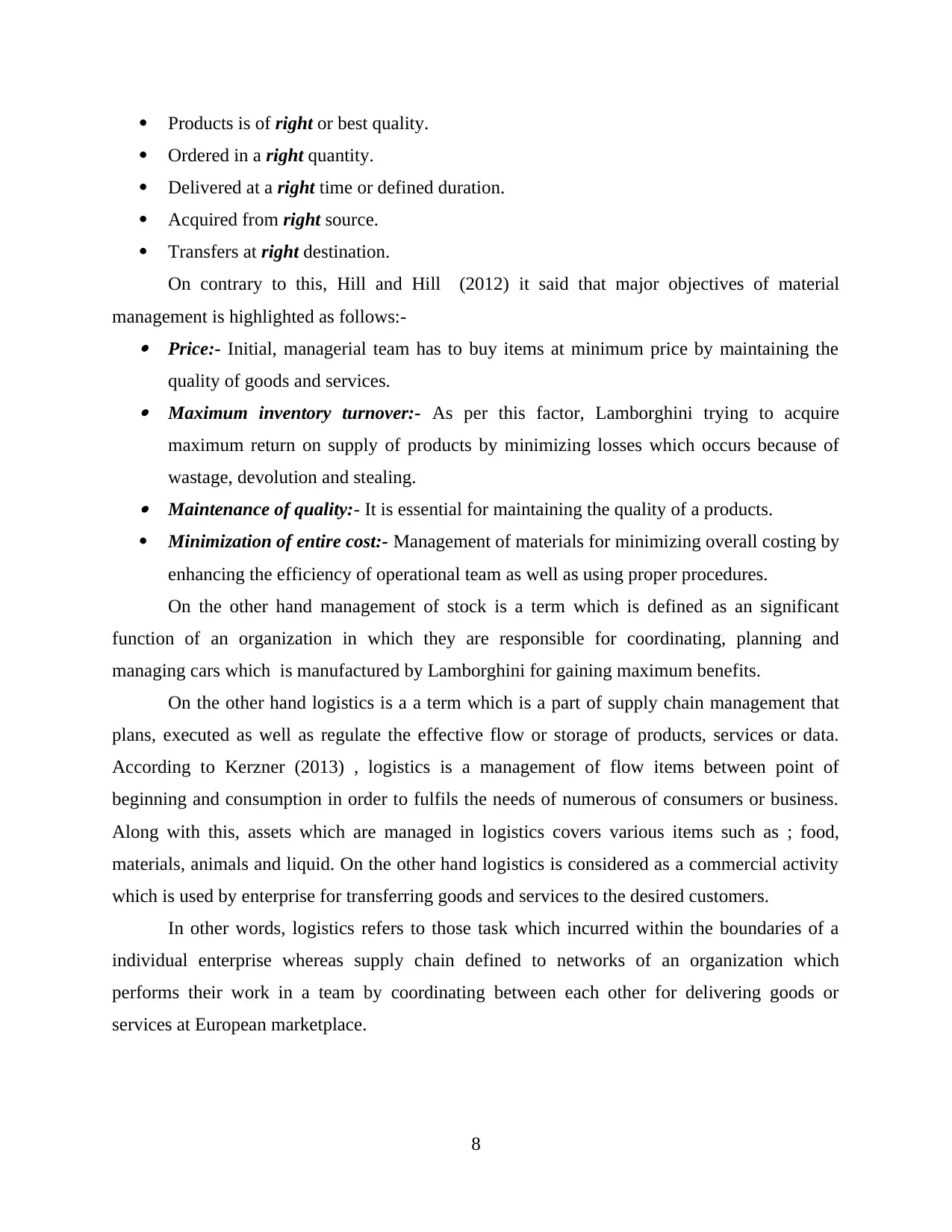
Products is of right or best quality.
Ordered in a right quantity.
Delivered at a right time or defined duration.
Acquired from right source.
Transfers at right destination.
On contrary to this, Hill and Hill (2012) it said that major objectives of material
management is highlighted as follows:- Price:- Initial, managerial team has to buy items at minimum price by maintaining the
quality of goods and services. Maximum inventory turnover:- As per this factor, Lamborghini trying to acquire
maximum return on supply of products by minimizing losses which occurs because of
wastage, devolution and stealing. Maintenance of quality:- It is essential for maintaining the quality of a products.
Minimization of entire cost:- Management of materials for minimizing overall costing by
enhancing the efficiency of operational team as well as using proper procedures.
On the other hand management of stock is a term which is defined as an significant
function of an organization in which they are responsible for coordinating, planning and
managing cars which is manufactured by Lamborghini for gaining maximum benefits.
On the other hand logistics is a a term which is a part of supply chain management that
plans, executed as well as regulate the effective flow or storage of products, services or data.
According to Kerzner (2013) , logistics is a management of flow items between point of
beginning and consumption in order to fulfils the needs of numerous of consumers or business.
Along with this, assets which are managed in logistics covers various items such as ; food,
materials, animals and liquid. On the other hand logistics is considered as a commercial activity
which is used by enterprise for transferring goods and services to the desired customers.
In other words, logistics refers to those task which incurred within the boundaries of a
individual enterprise whereas supply chain defined to networks of an organization which
performs their work in a team by coordinating between each other for delivering goods or
services at European marketplace.
8
Ordered in a right quantity.
Delivered at a right time or defined duration.
Acquired from right source.
Transfers at right destination.
On contrary to this, Hill and Hill (2012) it said that major objectives of material
management is highlighted as follows:- Price:- Initial, managerial team has to buy items at minimum price by maintaining the
quality of goods and services. Maximum inventory turnover:- As per this factor, Lamborghini trying to acquire
maximum return on supply of products by minimizing losses which occurs because of
wastage, devolution and stealing. Maintenance of quality:- It is essential for maintaining the quality of a products.
Minimization of entire cost:- Management of materials for minimizing overall costing by
enhancing the efficiency of operational team as well as using proper procedures.
On the other hand management of stock is a term which is defined as an significant
function of an organization in which they are responsible for coordinating, planning and
managing cars which is manufactured by Lamborghini for gaining maximum benefits.
On the other hand logistics is a a term which is a part of supply chain management that
plans, executed as well as regulate the effective flow or storage of products, services or data.
According to Kerzner (2013) , logistics is a management of flow items between point of
beginning and consumption in order to fulfils the needs of numerous of consumers or business.
Along with this, assets which are managed in logistics covers various items such as ; food,
materials, animals and liquid. On the other hand logistics is considered as a commercial activity
which is used by enterprise for transferring goods and services to the desired customers.
In other words, logistics refers to those task which incurred within the boundaries of a
individual enterprise whereas supply chain defined to networks of an organization which
performs their work in a team by coordinating between each other for delivering goods or
services at European marketplace.
8
Paraphrase This Document
Need a fresh take? Get an instant paraphrase of this document with our AI Paraphraser
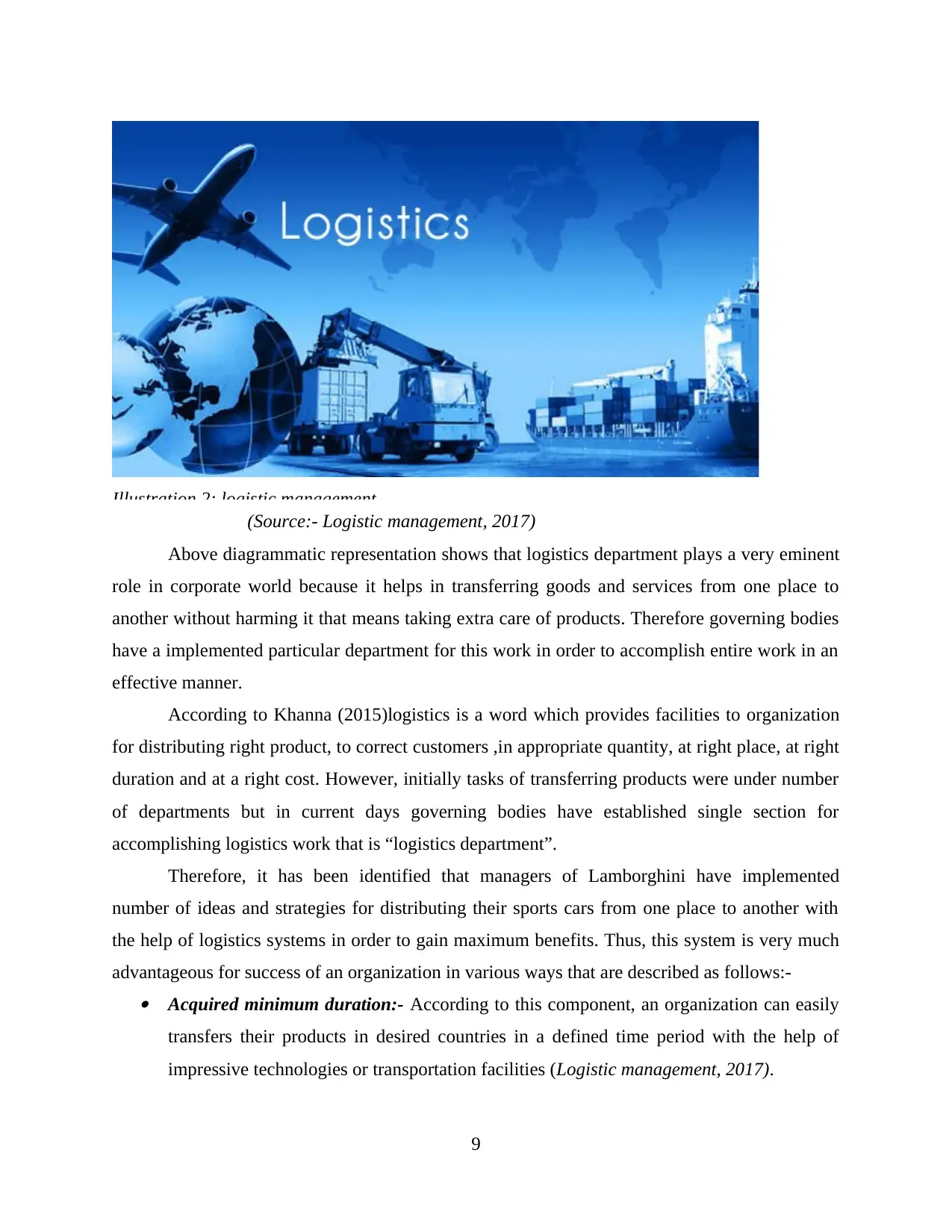
Illustration 2: logistic management
(Source:- Logistic management, 2017)
Above diagrammatic representation shows that logistics department plays a very eminent
role in corporate world because it helps in transferring goods and services from one place to
another without harming it that means taking extra care of products. Therefore governing bodies
have a implemented particular department for this work in order to accomplish entire work in an
effective manner.
According to Khanna (2015)logistics is a word which provides facilities to organization
for distributing right product, to correct customers ,in appropriate quantity, at right place, at right
duration and at a right cost. However, initially tasks of transferring products were under number
of departments but in current days governing bodies have established single section for
accomplishing logistics work that is “logistics department”.
Therefore, it has been identified that managers of Lamborghini have implemented
number of ideas and strategies for distributing their sports cars from one place to another with
the help of logistics systems in order to gain maximum benefits. Thus, this system is very much
advantageous for success of an organization in various ways that are described as follows:- Acquired minimum duration:- According to this component, an organization can easily
transfers their products in desired countries in a defined time period with the help of
impressive technologies or transportation facilities (Logistic management, 2017).
9
(Source:- Logistic management, 2017)
Above diagrammatic representation shows that logistics department plays a very eminent
role in corporate world because it helps in transferring goods and services from one place to
another without harming it that means taking extra care of products. Therefore governing bodies
have a implemented particular department for this work in order to accomplish entire work in an
effective manner.
According to Khanna (2015)logistics is a word which provides facilities to organization
for distributing right product, to correct customers ,in appropriate quantity, at right place, at right
duration and at a right cost. However, initially tasks of transferring products were under number
of departments but in current days governing bodies have established single section for
accomplishing logistics work that is “logistics department”.
Therefore, it has been identified that managers of Lamborghini have implemented
number of ideas and strategies for distributing their sports cars from one place to another with
the help of logistics systems in order to gain maximum benefits. Thus, this system is very much
advantageous for success of an organization in various ways that are described as follows:- Acquired minimum duration:- According to this component, an organization can easily
transfers their products in desired countries in a defined time period with the help of
impressive technologies or transportation facilities (Logistic management, 2017).
9
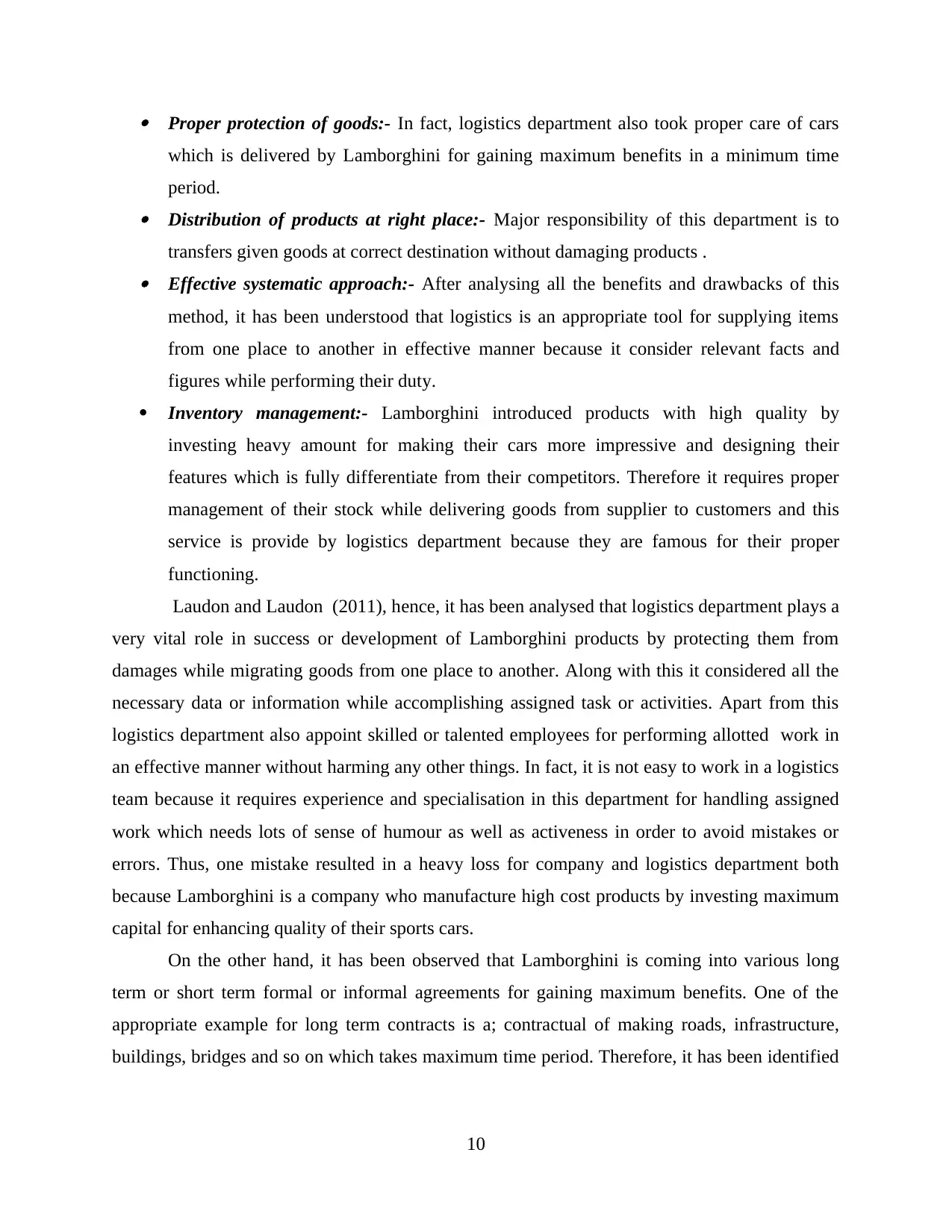
Proper protection of goods:- In fact, logistics department also took proper care of cars
which is delivered by Lamborghini for gaining maximum benefits in a minimum time
period. Distribution of products at right place:- Major responsibility of this department is to
transfers given goods at correct destination without damaging products . Effective systematic approach:- After analysing all the benefits and drawbacks of this
method, it has been understood that logistics is an appropriate tool for supplying items
from one place to another in effective manner because it consider relevant facts and
figures while performing their duty.
Inventory management:- Lamborghini introduced products with high quality by
investing heavy amount for making their cars more impressive and designing their
features which is fully differentiate from their competitors. Therefore it requires proper
management of their stock while delivering goods from supplier to customers and this
service is provide by logistics department because they are famous for their proper
functioning.
Laudon and Laudon (2011), hence, it has been analysed that logistics department plays a
very vital role in success or development of Lamborghini products by protecting them from
damages while migrating goods from one place to another. Along with this it considered all the
necessary data or information while accomplishing assigned task or activities. Apart from this
logistics department also appoint skilled or talented employees for performing allotted work in
an effective manner without harming any other things. In fact, it is not easy to work in a logistics
team because it requires experience and specialisation in this department for handling assigned
work which needs lots of sense of humour as well as activeness in order to avoid mistakes or
errors. Thus, one mistake resulted in a heavy loss for company and logistics department both
because Lamborghini is a company who manufacture high cost products by investing maximum
capital for enhancing quality of their sports cars.
On the other hand, it has been observed that Lamborghini is coming into various long
term or short term formal or informal agreements for gaining maximum benefits. One of the
appropriate example for long term contracts is a; contractual of making roads, infrastructure,
buildings, bridges and so on which takes maximum time period. Therefore, it has been identified
10
which is delivered by Lamborghini for gaining maximum benefits in a minimum time
period. Distribution of products at right place:- Major responsibility of this department is to
transfers given goods at correct destination without damaging products . Effective systematic approach:- After analysing all the benefits and drawbacks of this
method, it has been understood that logistics is an appropriate tool for supplying items
from one place to another in effective manner because it consider relevant facts and
figures while performing their duty.
Inventory management:- Lamborghini introduced products with high quality by
investing heavy amount for making their cars more impressive and designing their
features which is fully differentiate from their competitors. Therefore it requires proper
management of their stock while delivering goods from supplier to customers and this
service is provide by logistics department because they are famous for their proper
functioning.
Laudon and Laudon (2011), hence, it has been analysed that logistics department plays a
very vital role in success or development of Lamborghini products by protecting them from
damages while migrating goods from one place to another. Along with this it considered all the
necessary data or information while accomplishing assigned task or activities. Apart from this
logistics department also appoint skilled or talented employees for performing allotted work in
an effective manner without harming any other things. In fact, it is not easy to work in a logistics
team because it requires experience and specialisation in this department for handling assigned
work which needs lots of sense of humour as well as activeness in order to avoid mistakes or
errors. Thus, one mistake resulted in a heavy loss for company and logistics department both
because Lamborghini is a company who manufacture high cost products by investing maximum
capital for enhancing quality of their sports cars.
On the other hand, it has been observed that Lamborghini is coming into various long
term or short term formal or informal agreements for gaining maximum benefits. One of the
appropriate example for long term contracts is a; contractual of making roads, infrastructure,
buildings, bridges and so on which takes maximum time period. Therefore, it has been identified
10
⊘ This is a preview!⊘
Do you want full access?
Subscribe today to unlock all pages.

Trusted by 1+ million students worldwide
1 out of 19
Related Documents
Your All-in-One AI-Powered Toolkit for Academic Success.
+13062052269
info@desklib.com
Available 24*7 on WhatsApp / Email
![[object Object]](/_next/static/media/star-bottom.7253800d.svg)
Unlock your academic potential
Copyright © 2020–2025 A2Z Services. All Rights Reserved. Developed and managed by ZUCOL.





